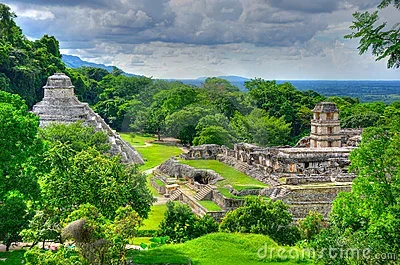
Mayas were a mysterious people. They ruled parts of Central America between 2600 BC and 1500 AD. Their relics are seen in Mexico, Belize Honduras and Guatemala. Though we have archaeological evidence from 2600 BC, their calendar begins from 11[SUP]th[/SUP] August 3114 BC. They were famous for their accurate calendar, written language, astronomical and mathematical systems. But all these came to our attention only because of their big and beautiful buildings. They built massive structures. The ruthless Spaniards came in 1540 and massacred a lot of people and plundered their gold. The Spaniards destroyed Maya culture and language, but couldn’t do anything to the architectural wonders because they were so huge.
Maya calendar begins on 11[SUP]th[/SUP] August 3114 BC. Indian calendar Kaliyuga begins in 3102 BC. But Hindu mythology is very clear about their existence long before Kali yuga. Kaliyuga is the last of the four yugas. But Mayas are silent about their existence before this date 3114 BC. The amazing co incidence between Hindus and Mayas, particularly their calendar years, was a puzzle. Now we have solved the puzzle with all the information available.
Mayas were Indian Nagas. They migrated after a big fight with Krishna and Arjuna. Both of them burnt the Khandava Vana (forest) for the sake of general public. But the tribal Naga people living inside the forest resented this act. It looks like lot of Nagas who resisted Arjuna and Krishna were killed. Indra was pro Nagas. But anti Naga Krishna had an earlier fight with another Naga leader called Kaliya. When he objected cowherds coming into his area Krishna went and killed Kaliya. Those who narrated the Puranic stories “Kaliya Mardhanam” slowly projected them as demons and snakes. But the fact of the matter is they were actually people who wore snake symbol (totem).
(Khandava Vana is called Gondwana land in geography lessons and the tribal Naga people are called Ghondus in anthropology lessons).
Following this clash, the enmity between the Nagas and Pandavas widened. Krishna died just before the Kaliyuga began. After all the Pandava brothers demise, the Nagas wanted to take a revenge on Arjuna’s grandson Parikshit. When they were waiting for an opportunity Parikshit was cursed by Shamika that he would die by “snake bite”. In reality the seer’s friend and tribal Naga leader Takshaka was given that task of “snake bite”. Takshaka challenged Parikshit and said that he would be assassinated within seven days. King Parikshit took all the precautions. But like Shivaji escaped in a fruit basket from the prison of mighty Moghul emperor Aurangazeb, Parikshit’s enemies entered Parikshit’s palace in a fruit basket and killed him. Puranas symbolically wrote that Parikshit was killed by “snake bite”.
Like Indira Gandhi’s assassination was followed by revenge attacks on Sikhs, Parikshit’s son Janamejayan went on a killing spree what was described symbolically as a Sarpa Yagna (snake sacrifice) on the banks of river Narmadha. A lot of Nagas were killed, actually massacred. The English word snake originated from Sanskrit word (s)naga.
Brahmin’s Peace Agreement
In those days mixed marriages existed and some Nagas were married to kings and Brahmins. One of them was a seer called Astika. He was asked to go as an emissary for peace talks, because his father Jaratkaru was married to a Naga woman. He was successful in his peace mission and stopped all the killings. Then started the Naga migration from a port called Patala . That is what Hindus called Patala loka (One of the seven worlds “below”the earth). The port was the gate way to Sri Lanka, South East Asia and South America. Hindu scriptures describe these lands as Naka Loka/ Naga Land. When Hindu mythologies said that Bali and other demon kings were sent to Patala Loka what they meant was they were banished from the mainland. Port Patala at the estuary of Indus river was mentioned even by foreign travellers. Broach (Bharukacha) was another port on the banks of river Narmadha. Both these ports handled much of the foreign trade with the West in ancient India.
When Arjuna burnt the Khandava Vana, one leader was allowed to escape from the burning. His name was Maya Danava. He thanked Arjuna and Yadavas for this and he constructed the palace for the Pandavas as a token of gratitude. He led a massive migration to South East Asia and then to Central America and South America. The day he left the holy Bharat was gratefully remembered by the Mayas as 11[SUP]th[/SUP] August 3114 BC. It coincided very well with the date of Janamejayan’s rule, Arjunas great grandson, around 3100 BC.
Brahmins are doing an amazing thing thrice a day. They recite the 5000 year old Peace Agreement during their daily ritual called Sandhyavandhanam. They praise the Nagas as Maha Yasa: (Great and famous people) and request them to keep away in the name of Astika and Jaratkaru. The mantra starts with Narmadhayai Nama: (Salute to river Narmadha!).
(Please read Brahmins deserve an entry into Guinness Book of Records)
Divine garments and Nagas:
Nagas were expert weavers. They had some special type of clothes which were so nice and looked exactly like snake skin. 2000 year old Sangam Tamil literature refers to this cloth in two places (Porunar. Lines 82-83;Puram.383). In another place King Ay was praised by Nallur Nathaththanar for giving the rarest Naga cloth to Lord Shiva (Sirupan. Lines 96-99). It means that he adorned Shiva’s statue with the cloth. It was presented to Ay by Neela Nagan.
Sanskrit literature is also replete with such references. Karkotakan, Naga tribal leader, gave Nala a rare cloth to reveal his identity to his wife Damayanti when both were separated. So this is a rare type of cloth only certain people can afford to buy it. It is in Mahabharata (3/73-3).
(Please read Amazing similarities between Mayas and Hindus (Nagas)
